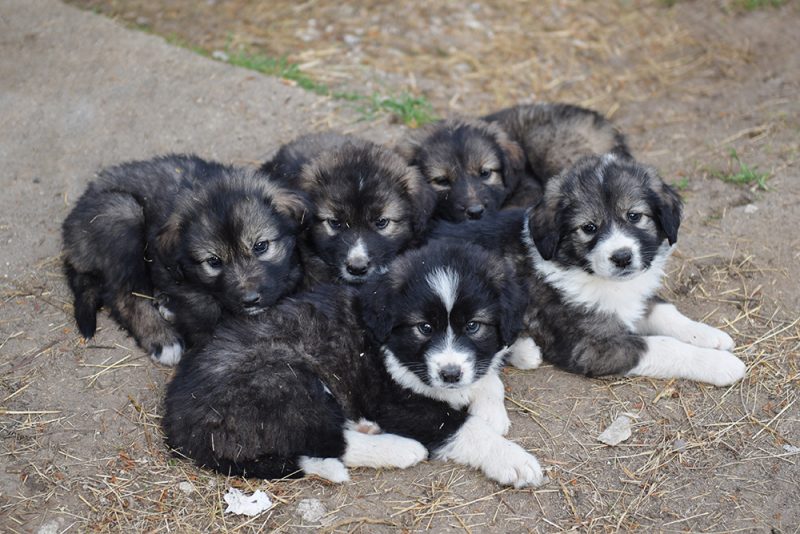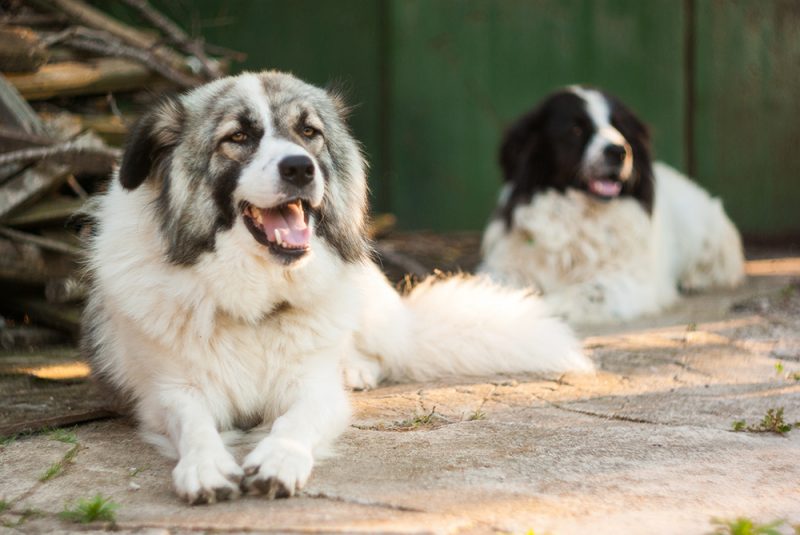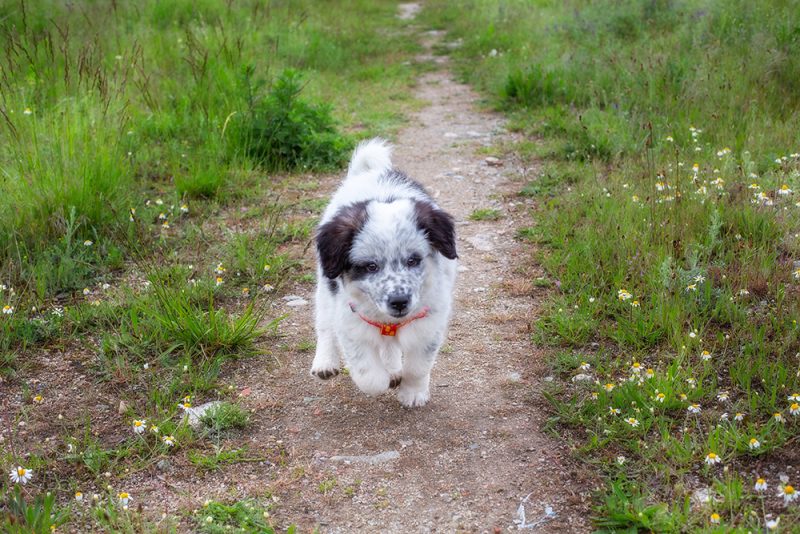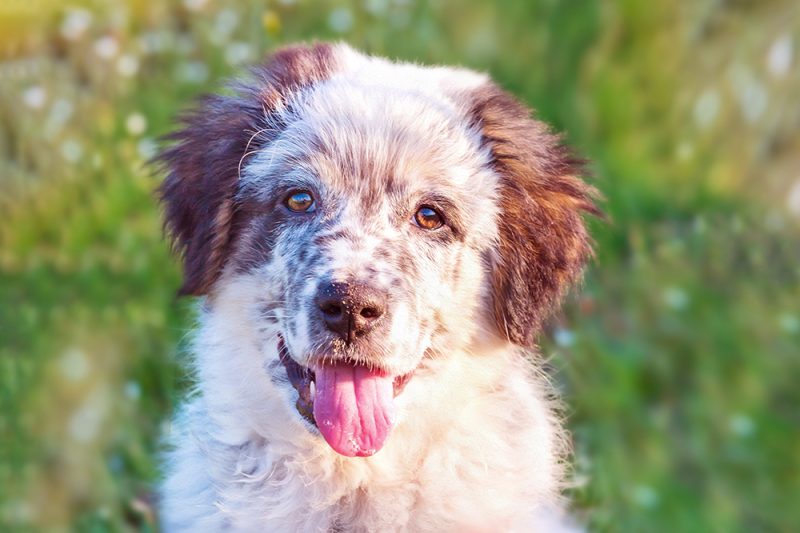Click Below to Skip Ahead
The Karakachan, also sometimes called the Bulgarian Shepherd, is a striking animal with a history that places them with the ancient breeds. It is a livestock guardian dog that is well-developed for this work, but there is far more to know about these dogs if you’re considering bringing one home, such as how much exercise they require, their temperament, and more.
Breed Overview
Colors:
White, black, brown, brindle
Suitable for:
Experienced pet owners looking for a guardian dog
Temperament:
Loyal, courageous, intelligent
The Karakachan is a hard-working dog, displaying devotion and courage, especially while on the job. They are lesser-known members of a group of livestock guardian animals called Molossers. One of their defining features is a massive skull with a medium-sized muzzle that adds to their bite force. Enthusiasts selectively bred other brachycephalic dogs, like Mastiffs, for fighting because of this trait.
It’s hard to imagine a tougher dog than the Karakachan. Like many livestock guardians, they aren’t vocal animals. When they speak, you’d be well-advised to pay attention to their warning. They aren’t herders like vocal Border Collies, though. This breed has a loyal following but is not recognized by national dog registries.
However, the Bulgarian Republican Federation of Cynology has given the breed this status, but it’s no longer a part of the International Federation Cynologique Internationale (FCI). That complicates issues with pedigrees and finding a puppy. The Serbian Cinology Association now issues pedigrees for Karakachan pups. The survival of the breed is a testament to the dog’s value and endearing qualities.
Karakachan Characteristics

Karakachan Puppies


Finding a Karakachan puppy is very challenging, given the breed’s status and lack of official recognition. The history of the dog speaks to a lesser-known use. There’s also a lot of competition in that field from other livestock guardians, such as the Great Pyrenees. The Karakachan fills a narrow niche, which accounts for the dog’s rarity.
Speculating on the cost is difficult. The chances are you’ll find pet-quality animals at more affordable prices than dogs from lines with a proven track record of superior performance in the field. Our advice is to be patient if you’re set on getting a Karakachan puppy. The International Karakachan Dog Association (MAKK) and the American Karakachan Dog Association (AKDA) are excellent places to start.
The good news is that the breed is well-conserved by enthusiasts who want the dog to remain true to their roots. The Karakachan is not a part of the Orthopedic Foundation for Animals (OFA). This organization provides recommended testing information for conditions associated with specific breeds and is an official repository of this information. That puts the onus on you to research sellers.
Understanding your commitment to pet ownership is imperative, especially with a Karakachan. This breed’s role encouraged problem-solving skills and independence. These dogs require dedicated and engaged individuals to train and socialize these animals. They are work-focused and won’t transition from the field to the couch well.
Karakachan Breed Origin & History
The Karakachan is an old European breed. It’s an example of the function dogs initially served for humans. This dog wasn’t a family pet but a working member of the farm. The breed’s name comes from the shepherds of the area. The breed’s history goes back thousands of years to 5 BC and the Thracians of Southeast Europe.
Their nomadic nature and the environmental demands of the area helped shape the breed into what we know today. These dogs still guard flocks in their native land. Enthusiasts encourage the traits that define them and help them in these roles. Their usefulness is well-known in the continent, with people using them for similar work in Macedonia and Greece.
Interestingly, the Bulgarian government didn’t officially recognize them until 2005. That may explain the lack of other official recognition worldwide. Historically, the Karakachan was one tough animal. This pup didn’t back down from the challenges of formidable predators like wolves and bears. This history accounts for many traits we see in these pets today. It also validates our advice about training and socialization.



Temperament & Intelligence of the Karakachan 🧠
Dogs that work independently develop excellent problem-solving skills. The Karakachan is no exception. It’s underscored by the nomadic nature of the people who selectively bred this canine. A pup would have to use these skills in new places to do their job properly. That’s a great thing if you need a reliable livestock guardian. However, it can be challenging for novice pet owners.
The Karakachan is an adaptable dog but needs a fenced yard, which they will guard tenaciously and fiercely. They are very loyal to their family and are wary of strangers.
Are These Dogs Good for Families? 👪
The Karakachan isn’t an aggressive dog, despite the breed’s history. However, aggression is normal canine behavior if an animal feels threatened. We don’t recommend this dog in households with small children. They will tolerate older kids who respect their space, but this pooch can be intense during playtime. Therefore, we suggest supervising time with the children.
Does This Breed Get Along With Other Pets? 🐶 😽
Karakachans have a strong prey drive because of their jobs historically. That makes them instinctively on guard with other animals. They are territorial. We don’t recommend this breed in households with other pets. This dog will likely give chase to a cat or dog running away from them. They may tolerate animals raised together with them. However, we’d err on the side of caution.

Things to Know When Owning a Karakachan
The Karakachan needs an experienced pet owner who understands the challenges of dealing with these kinds of dogs. We mentioned this pup’s fierce loyalty. That can make them sensitive to harsh words or punishment. The intelligence of this animal means you must give your pooch something to do to prevent boredom and destructive behavior.
Food & Diet Requirements 🦴
Giving your pet a diet suitable for their size and life stage is vital for proper growth and development. Large dogs like the Karakachan mature more slowly than small pups like terriers. You should feed your puppy three to four times daily, keeping them on a schedule to monitor their intake. We don’t recommend free feeding, as this breed is moderately prone to weight gain.
You should switch to an adult maintenance diet once your pet has reached sexual maturity. We suggest discussing your dog’s food intake with your vet to ensure the animal’s nutritional needs are met. We recommend a high-quality commercial product formulated for large and giant breeds. Puppies need a diet with 22.5% protein and 8.5% fat for good health. You should ensure fresh water is always available.


Exercise 🐕
Daily exercise is imperative for the Karakachan. That will safeguard the animal’s physical and mental well-being. Time outside will provide welcome enrichment and opportunities to introduce your pet to novel experiences to prevent fearfulness. This dog will act aggressively against potential threats. An active social life removes the unknown element that can trigger negative reactions.
We don’t recommend taking your Karakachan to dog parks unless you socialize your pet with other dogs while young. Brisk walks will provide the necessary exercise and time to hone your pet’s leash manners. You should aim for at least an hour of daily activity to keep your pup healthy. Regular interaction with your pet will provide enrichment and mental stimulation.
Training 🎾
The Karakachan requires an owner committed to training and socializing their dog. That should begin on day one. Consistency is critical for success. We recommend a Nothing-in-Life-Is-Free (NILIF) approach to prevent dominance issues, often a concern with independent animals. Using treats as training aids for positive reinforcement is an excellent way to achieve this goal.
Grooming ✂️
You’ll find short-haired and long-haired Karakachans, each with a thick undercoat. We recommend brushing your pet a couple of times weekly to prevent mats. This breed is a heavy shedder, making this task necessary to cut down on the hair. They also have a moderate tendency to drool.
You should also check your pup’s ears for signs of an infection, which is sometimes a problem with animals with dense coats. Trim your dog’s nails as necessary. We suggest touching your pooch’s paws and ears to get them used to being handled. Occasional baths will also keep your pet looking their best.


Health and Conditions ❤️
The Karakachan is generally a healthy dog. That’s one benefit of being off the radar. Hip dysplasia is always a concern with large breeds. One study found that working dogs were more likely to develop this condition. We recommend buying only from sellers who conduct pre-breeding screening on their dogs to prevent it from being passed onto their offspring.
Only get a puppy from a breeder who offers a health guarantee since some issues appear later in the animal’s life. Don’t be afraid to ask questions, given the unclear pedigree situation with this breed. Request to see the mother and littermates. We recommend getting a puppy at least 8 weeks old or preferably 12 weeks.
Serious Conditions
- Hip and elbow dysplasia
- Patellar luxation
- Bloat
Male vs. Female
The sexual dimorphism between males and females is significant if size is an issue, as males tend to be larger. However, either sex will make a delightful pet, but upbringing and the environment are the most important influences on the dog’s temperament.

3 Little-Known Facts About the Karakachan
1. A Karakachan Puppy Helped Solidify an Important Deal
Negotiations in 2010 for a pipeline to supply gas to Europe hit a snag until Bulgaria presented Russian Prime Minister Vladimir Putin with a Karakachan puppy. What else can you give someone who has everything, including a Siberian Tiger cub?
2. The Karakachan Has a Global Influence
Vladimir Putin wasn’t the only foreign dignitary to receive a Karakachan puppy. The country also gave one to US President George W. Bush in 2003. The Bulgarians knew what a treasure the country had in their adorable pups.
3. Being Overly Aggressive or Shy Are Faults
The official standard for the breed is specific about the expected behavior of the Karakachan. It also dings being too unemotional or disinterested. After all, a livestock guardian must be alert and responsive.


Does the Karakachan Make a Good Pet?
The Karakachan is a loyal pet that will protect their family against danger. They take their jobs seriously. They are independent animals with a keen prey drive and wanderlust potential. Their focus is their charges and tracking down threats. This pup has the stamina and brawn for the task. While they are admirable traits, they may not be the best choice for households looking for a family pet.
However, the Karakachan is an affectionate dog and will get attached to family members. They are eager to please yet sensitive to punishment. This dog needs an attentive owner who will spend time training and exercising their pet. This breed is challenging to train, making an experienced individual critical for success.

Conclusion
The Karakachan is an ancient breed with a long history of loyalty and courage. This dog is adaptable and intelligent, traits vital for their work. However, they aren’t for everyone. They require a commitment to ongoing training and socialization. Perhaps that’s part of their desirability. It undoubtedly will forge a strong bond between the dog and their owner that some people want in a pet.
Featured Image Credit: Jennifer Kramer, Shutterstock
